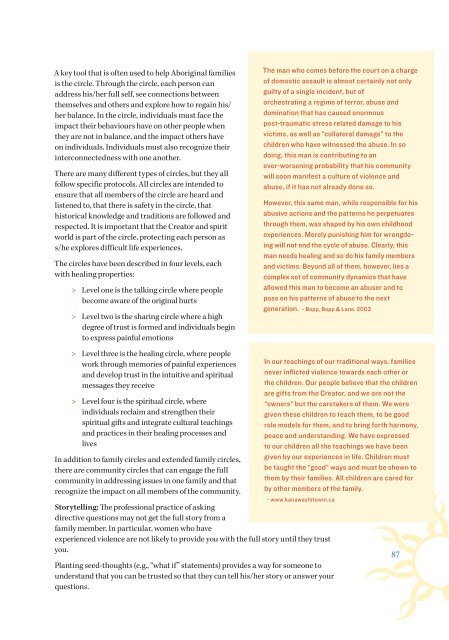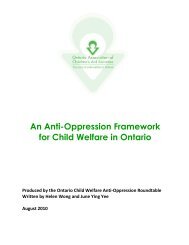English - Ontario Association of Children's Aid Societies
English - Ontario Association of Children's Aid Societies
English - Ontario Association of Children's Aid Societies
You also want an ePaper? Increase the reach of your titles
YUMPU automatically turns print PDFs into web optimized ePapers that Google loves.
A key tool that is <strong>of</strong>ten used to help Aboriginal families<br />
is the circle. Through the circle, each person can<br />
address his/her full self, see connections between<br />
themselves and others and explore how to regain his/<br />
her balance. In the circle, individuals must face the<br />
impact their behaviours have on other people when<br />
they are not in balance, and the impact others have<br />
on individuals. Individuals must also recognize their<br />
interconnectedness with one another.<br />
There are many different types <strong>of</strong> circles, but they all<br />
follow specific protocols. All circles are intended to<br />
ensure that all members <strong>of</strong> the circle are heard and<br />
listened to, that there is safety in the circle, that<br />
historical knowledge and traditions are followed and<br />
respected. It is important that the Creator and spirit<br />
world is part <strong>of</strong> the circle, protecting each person as<br />
s/he explores difficult life experiences.<br />
The circles have been described in four levels, each<br />
with healing properties:<br />
> > Level one is the talking circle where people<br />
become aware <strong>of</strong> the original hurts<br />
> > Level two is the sharing circle where a high<br />
degree <strong>of</strong> trust is formed and individuals begin<br />
to express painful emotions<br />
> > Level three is the healing circle, where people<br />
work through memories <strong>of</strong> painful experiences<br />
and develop trust in the intuitive and spiritual<br />
messages they receive<br />
> > Level four is the spiritual circle, where<br />
individuals reclaim and strengthen their<br />
spiritual gifts and integrate cultural teachings<br />
and practices in their healing processes and<br />
lives<br />
In addition to family circles and extended family circles,<br />
there are community circles that can engage the full<br />
community in addressing issues in one family and that<br />
recognize the impact on all members <strong>of</strong> the community.<br />
Storytelling: The pr<strong>of</strong>essional practice <strong>of</strong> asking<br />
directive questions may not get the full story from a<br />
family member. In particular, women who have<br />
experienced violence are not likely to provide you with the full story until they trust<br />
you.<br />
Planting seed-thoughts (e.g., “what if” statements) provides a way for someone to<br />
understand that you can be trusted so that they can tell his/her story or answer your<br />
questions.<br />
The man who comes before the court on a charge<br />
<strong>of</strong> domestic assault is almost certainly not only<br />
guilty <strong>of</strong> a single incident, but <strong>of</strong><br />
orchestrating a regime <strong>of</strong> terror, abuse and<br />
domination that has caused enormous<br />
post-traumatic stress related damage to his<br />
victims, as well as “collateral damage” to the<br />
children who have witnessed the abuse. In so<br />
doing, this man is contributing to an<br />
ever-worsening probability that his community<br />
will soon manifest a culture <strong>of</strong> violence and<br />
abuse, if it has not already done so.<br />
However, this same man, while responsible for his<br />
abusive actions and the patterns he perpetuates<br />
through them, was shaped by his own childhood<br />
experiences. Merely punishing him for wrongdoing<br />
will not end the cycle <strong>of</strong> abuse. Clearly, this<br />
man needs healing and so do his family members<br />
and victims. Beyond all <strong>of</strong> them, however, lies a<br />
complex set <strong>of</strong> community dynamics that have<br />
allowed this man to become an abuser and to<br />
pass on his patterns <strong>of</strong> abuse to the next<br />
generation. - Bopp, Bopp & Lane, 2003<br />
In our teachings <strong>of</strong> our traditional ways, families<br />
never inflicted violence towards each other or<br />
the children. Our people believe that the children<br />
are gifts from the Creator, and we are not the<br />
“owners” but the caretakers <strong>of</strong> them. We were<br />
given these children to teach them, to be good<br />
role models for them, and to bring forth harmony,<br />
peace and understanding. We have expressed<br />
to our children all the teachings we have been<br />
given by our experiences in life. Children must<br />
be taught the “good” ways and must be shown to<br />
them by their families. All children are cared for<br />
by other members <strong>of</strong> the family.<br />
- www.kanawayhitowin.ca<br />
87

















